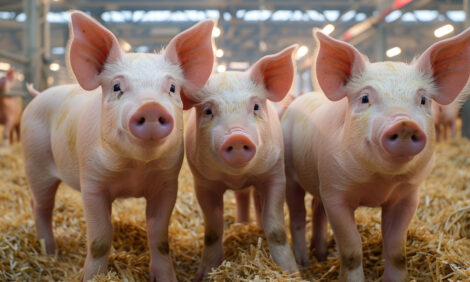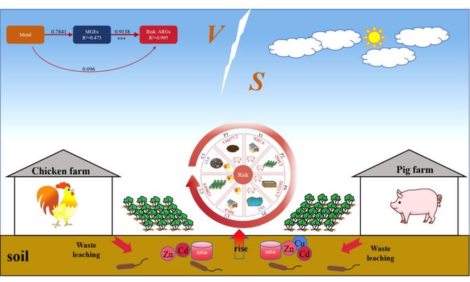



US Pork Exports To Decline, Pork Outlook Report: March 2002
By U.S.D.A., Economic Research Service - This article is an extract from the March 2002: Livestock, Dairy and Poultry Situation and Outlook Report, highlighting Pork Industry data. The report states that red meat and poultry exports remain unchanged in 2002 and forcasts US pork exports are set to decline.| Red Meat and Poultry Exports Unchanged In 2002 |

|
Red meat and poultry exports are expected to total about 10.7 billion pounds this year,
unchanged from 2001. The increase in poultry exports will offset the decline in red
meats. However, the recently announced ban on U.S. poultry exports by Russia raises
uncertainties about the growth in poultry exports. Russia accounts for about 36 percent
of all U.S. poultry meat exports. Forecasts may be adjusted as more information
becomes available.
Red meat exports are expected to total about 3.68 billion pounds this year, down 4
percent from last year as both beef and pork exports decline. The decline in red meat
exports is largely due to a strong dollar, worldwide economic weakness, and increased
competition from other countries. Japan--the largest customer for U.S. red meat--is
expected to have a lackluster demand for U.S. red meats this year.
Imports of hogs and cattle are expected to increase this year as relatively low grain
prices, the strong dollar, and relatively high feeder animal prices make the United States
an attractive market for Canada and Mexico. Hog imports are expected to total about 5.8
million head, while cattle imports total about 2.5 million head.
Dairy prices are expected to average considerably lower in 2002, as substantial recovery
in milk production outstrips somewhat weaker growth in dairy demand. However, prices
will stay well above those of 2000 because of still-strong demand and hindrances to
expanding dairy herds. Milk prices shot to almost $15 per hundredweight (cwt) in 2001
because of extraordinary demand, output-slowing problems during the first half, and a
very sluggish production recovery in the second half.
| Pork Exports To Decline |
The United States exported 1.56 billion pounds of
pork in 2001, 21 percent more than in 2000. U.S.
pork exports in 2002 are expected to be about 5
percent lower than 2001, given current
expectations for static market growth in Japan, and
increased competition from Canadian pork
products in Mexico. U.S. imports of live hogs
from Canada are expected to increase about 9
percent this year. Feeder pigs are expected to
comprise more than 60 percent of live hog imports
from Canada in 2002.
The most important foreign markets for U.S. pork
in 2001 were Japan--with a 48-percent share of
U.S. pork exports; Mexico, with a 20-percent
share; and Canada, which accounted for 12 percent
of U.S. pork exports. Although very small
markets, Russia and the European Union were the
fastest growing markets for U.S. pork in 2001, with
year-over-year changes of 205 and 480 percent,
respectively. These two markets are characterized
by significant year-to-year volatility and together
accounted for less than 10 percent of U.S. exports
last year.
Total Japanese pork imports in 2002 are expected
to be about the same as last year. The key
determinants of 2002 Japanese pork import demand
are likely to be BSE-related developments, and
how the Japanese Government addresses
consumers’ food-safety concerns. The appearance
of more BSE-afflicted cattle in Japan would likely
cause consumers to further substitute pork in place
of beef in their diets. In addition, the means chosen
by the Japanese Government to resolve the various
meat-labeling scandals that occurred in late 2001
have implications for Japanese meat demand. Meat
consumption growth in Japan is contingent on
consumers’ confidence in the system that delivers
meat products to retail outlets. Lack of consumer
confidence in meat delivery systems may
negatively impact Japanese pork imports.
Although the current safeguard (The safeguard is a
WTO-legal means of slowing surges of imports
that damage domestic producers, by increasing the
minimum pork import price) is due to expire at the
beginning of the new Japanese fiscal year on April
1, it is possible that the safeguard could be re-imposed
later in the year. As in the past, a
safeguard would likely favor high-end, fresh cuts
from the United States and Canada, at the expense
of frozen pork products. The effects of another
safeguard in 2002 are largely dependent on how the
BSE situation develops in Japan. Clearly, when
BSE is a factor in the Japanese market, the
safeguard loses relevance. Japanese consumers are
more willing to pay higher, safeguard-driven prices
for pork when BSE is in the news.
U.S. exports to Mexico are expected to increase in
2002, but U.S. exporters will likely continue to be
challenged for shares of the Mexican market by
Canadian exporters. A strong U.S. dollar may
continue to provide incentives for Mexican buyers
to switch to lower priced Canadian pork products.
The United States imported slightly less pork in
2001-- about 950 million pounds, or 2 percent less
than in 2000. The decrease is attributable to the
brief period in the spring when Denmark was
barred from the U.S. market because of the
European FMD outbreak. Imports in 2002 are
expected to be about the same as last year, with
Canada continuing to increase its share of the U.S.
market. An expanding pork industry in Canada
allows U.S. buyers to source Canadian cuts more
conveniently and more cheaply than Danish
products.
The United States imported 5.3 million hogs from
Canada last year, 59 percent of which were feeder
pigs. Animal and Plant Health Inspection Service
data indicate that the destination States for over 93
percent of Canadian feeder pig imports were
located in the U.S. Corn Belt (Iowa, Kansas,
Missouri, Nebraska, Illinois, Indiana, Michigan,
Minnesota, Ohio, and Wisconsin). Seventy-two
percent of Canadian barrows and gilts for slaughter
were destined for the Dakotas or States west of the
Rocky Mountains. Only 12 percent of barrows and
gilts imported from Canada were shipped to Corn
Belt States. In short, hog flows from Canada
reflect the “pull” of available slaughter space and
cheap feed. Current import expectations for 2002
reflect large breeding herd expansions in Manitoba
and Ontario, as reported by Statistics Canada in
February. The United States is expected to import
roughly 5.8 million hogs from Canada in 2002.

More information including all the figures and graphs is avaiable in the full 38 page report, see below for details.
Links
For more information view the full Livestock, Dairy and Poultry Situation and Outlook (pdf)Source: Livestock, Dairy and Poultry Situation and Outlook - U.S. Department of Agriculture, Economic Research Service - March 26, 2002








